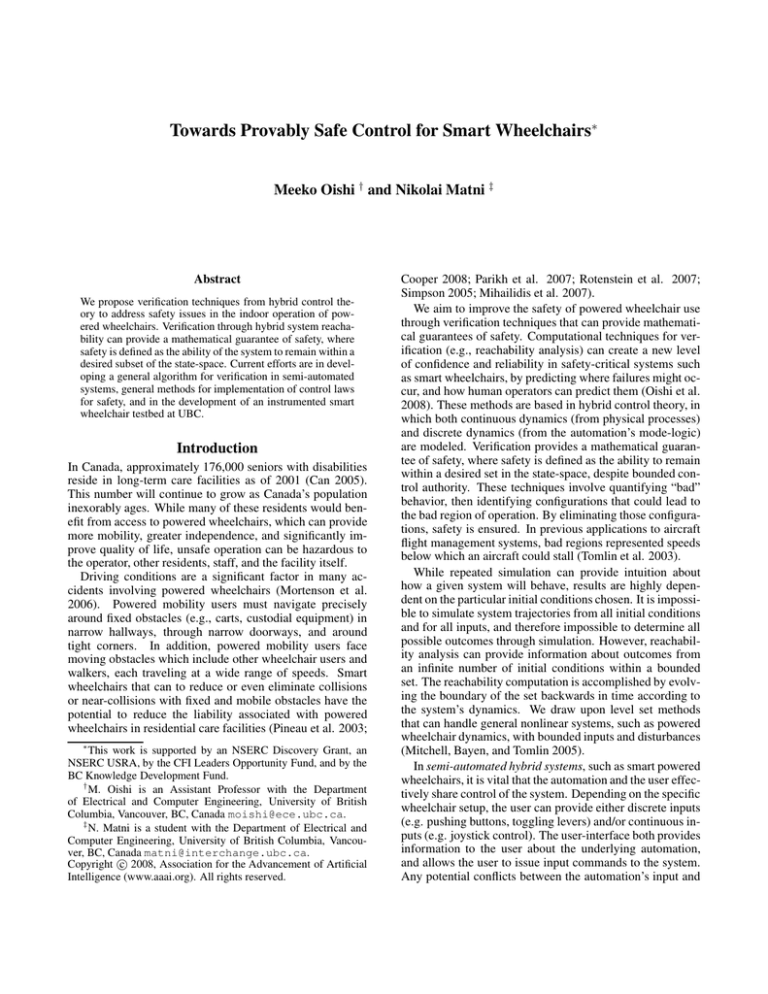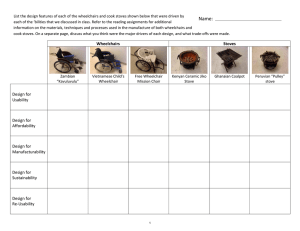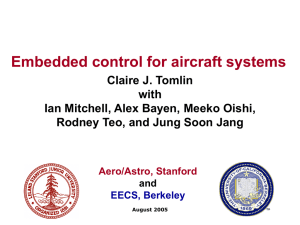
Towards Provably Safe Control for Smart Wheelchairs∗
Meeko Oishi † and Nikolai Matni ‡
Abstract
We propose verification techniques from hybrid control theory to address safety issues in the indoor operation of powered wheelchairs. Verification through hybrid system reachability can provide a mathematical guarantee of safety, where
safety is defined as the ability of the system to remain within a
desired subset of the state-space. Current efforts are in developing a general algorithm for verification in semi-automated
systems, general methods for implementation of control laws
for safety, and in the development of an instrumented smart
wheelchair testbed at UBC.
Introduction
In Canada, approximately 176,000 seniors with disabilities
reside in long-term care facilities as of 2001 (Can 2005).
This number will continue to grow as Canada’s population
inexorably ages. While many of these residents would benefit from access to powered wheelchairs, which can provide
more mobility, greater independence, and significantly improve quality of life, unsafe operation can be hazardous to
the operator, other residents, staff, and the facility itself.
Driving conditions are a significant factor in many accidents involving powered wheelchairs (Mortenson et al.
2006). Powered mobility users must navigate precisely
around fixed obstacles (e.g., carts, custodial equipment) in
narrow hallways, through narrow doorways, and around
tight corners. In addition, powered mobility users face
moving obstacles which include other wheelchair users and
walkers, each traveling at a wide range of speeds. Smart
wheelchairs that can to reduce or even eliminate collisions
or near-collisions with fixed and mobile obstacles have the
potential to reduce the liability associated with powered
wheelchairs in residential care facilities (Pineau et al. 2003;
∗
This work is supported by an NSERC Discovery Grant, an
NSERC USRA, by the CFI Leaders Opportunity Fund, and by the
BC Knowledge Development Fund.
†
M. Oishi is an Assistant Professor with the Department
of Electrical and Computer Engineering, University of British
Columbia, Vancouver, BC, Canada moishi@ece.ubc.ca.
‡
N. Matni is a student with the Department of Electrical and
Computer Engineering, University of British Columbia, Vancouver, BC, Canada matni@interchange.ubc.ca.
c 2008, Association for the Advancement of Artificial
Copyright Intelligence (www.aaai.org). All rights reserved.
Cooper 2008; Parikh et al. 2007; Rotenstein et al. 2007;
Simpson 2005; Mihailidis et al. 2007).
We aim to improve the safety of powered wheelchair use
through verification techniques that can provide mathematical guarantees of safety. Computational techniques for verification (e.g., reachability analysis) can create a new level
of confidence and reliability in safety-critical systems such
as smart wheelchairs, by predicting where failures might occur, and how human operators can predict them (Oishi et al.
2008). These methods are based in hybrid control theory, in
which both continuous dynamics (from physical processes)
and discrete dynamics (from the automation’s mode-logic)
are modeled. Verification provides a mathematical guarantee of safety, where safety is defined as the ability to remain
within a desired set in the state-space, despite bounded control authority. These techniques involve quantifying “bad”
behavior, then identifying configurations that could lead to
the bad region of operation. By eliminating those configurations, safety is ensured. In previous applications to aircraft
flight management systems, bad regions represented speeds
below which an aircraft could stall (Tomlin et al. 2003).
While repeated simulation can provide intuition about
how a given system will behave, results are highly dependent on the particular initial conditions chosen. It is impossible to simulate system trajectories from all initial conditions
and for all inputs, and therefore impossible to determine all
possible outcomes through simulation. However, reachability analysis can provide information about outcomes from
an infinite number of initial conditions within a bounded
set. The reachability computation is accomplished by evolving the boundary of the set backwards in time according to
the system’s dynamics. We draw upon level set methods
that can handle general nonlinear systems, such as powered
wheelchair dynamics, with bounded inputs and disturbances
(Mitchell, Bayen, and Tomlin 2005).
In semi-automated hybrid systems, such as smart powered
wheelchairs, it is vital that the automation and the user effectively share control of the system. Depending on the specific
wheelchair setup, the user can provide either discrete inputs
(e.g. pushing buttons, toggling levers) and/or continuous inputs (e.g. joystick control). The user-interface both provides
information to the user about the underlying automation,
and allows the user to issue input commands to the system.
Any potential conflicts between the automation’s input and
the user’s input must be resolved, and communicated to the
user such that the user understands the state of the automation and can easily predict its evolution (Sheridan 1999).
Human-automation interaction problems can be difficult to
detect through simple inspection (Sarter and Woods 1995;
Degani and Heymann 2002; Oishi et al. 2002; Umeno and
Lynch 2007), hence our work is in extending verification
techniques for standard, fully-automated systems to accommodate semi-automated hybrid systems.
While a highly trained, specialized group of users, such as
pilots, may exhibit a great deal of uniformity in their interaction with automation, users of assistive technologies will
have significantly more variation in their interaction with automation, depending on their particular physical and/or cognitive disabilities. Our approach therefore is to model the
user’s intent by specifying broad bounds on what the user
can do, rather than trying to model an individual user’s or
prototype user’s dynamics. This allows us to capture the
user’s intent in a way that is mathematically tractable for hybrid system verification techniques. Standard control techniques assume unlikely extremes (that the human is acting
as precisely as an automation, or alternatively, that the human is a disturbance actively driving the system to unsafety).
Neither of these captures the types of inadvertent mishaps
that occur in many systems.
Recently we have explored how the verification algorithm
for semi-automated systems differs depending on the type of
user-input (Matni and Oishi 2008). We are currently designing generic algorithms for user-interface design based on our
modified application of reachability analysis for safety verification in semi-automated systems, and implementing our
computational results onboard actual physical testbeds. We
describe our efforts to implement the reachability calculation on a physical system (discretized over space and time)
in a manner which upholds the desired safety guarantees.
Reachability analysis for safety verification
We identify “safe” regions of the state space by computing
the reachable set W(t), which is the largest controlled invariant set within a given constraint set W0 . For a continuous system ẋ = f (x, u), u ∈ U ⊆ Rm , x ∈ Rn , we compute W(t) in backwards time. The constraint set is encoded
implicitly as a level set function J0 : X → R
W0 = {x ∈ X | J0 (x) ≥ 0}.
(1)
then the boundary of the constraint set is propagated backwards in time according to the system dynamics. Finding
the backwards reachable set W(t) requires solving the terminal value time-dependent modified Hamilton-Jacobi (HJ)
partial differential equation (PDE) (Tomlin et al. 2003)
∂J(x,t)
= 0
for t < 0
+ min 0, H x, ∂J(x,t)
∂t
∂x
J(x, 0) = J0 (x) for t = 0
(2)
with
∂J(x, t) T
∂J(x, t)
= max
H x,
f (x, u).
(3)
u∈U
∂x
∂x
W0 (t)
Constraint set
W(t)
Reachable set
(safe)
X
As shown in (Tomlin et al. 2003), we obtain an implicit representation of the reachable set W(t) = {x ∈
X | J(x, t) ≥ 0} as well as a control law which, if enforced
along the boundary of the reachable set, will ensure that the
state of the system will never exit W(t) and therefore never
exit W0 . The complete algorithm for hybrid system reachability analysis and controller synthesis is detailed in (Tomlin
et al. 2003).
In practice, the computation is accomplished by discretizing the state space into intervals of width Δx and evolving
(2) on each of the grid points according to standard numerical integration routines.
Towards implementing safe control laws
The reachability calculation provides a guarantee of safety
for states that remain within the reachable set. Once the
state exists the reachable set, safety can no longer be guaranteed. Hence in implementation, we cannot allow the system
to cross the boundary of the reachable set. In addition, as it
is rare to have an analytic solutions for W(t) we must rely
on the computational solution, which is defined only at grid
points used in the reachability calculation. In implementing the reachable set for values of x which do not lie on the
˜ t) = min {xk ∈ N (x)}J(xk , t), with
grid, we choose J(x,
N (x) the set of neighboring grid points of x, which is the
most conservative approximation (e.g., closest to unsafety)
of J(x, t). Measurements of the physical system occur every
T seconds.
A naive method of preventing boundary crossings, and
therefore ensuring safety, is to create a subset of the reachable set W(t) ⊇ W (t) = {x ∈ X | J(x, t) ≥ } and to
enforce the control law for safety immediately after detecting a boundary crossing of W (t). However, this requires
trial-and-error to find an appropriate value of , and provides
no guarantee that the boundary crossing will be detected for
x ∈ W(t) ∩ W (t) (e.g., it is possible that the boundary
crossing might not be detected until x ∈ W(t)). It is also
possible that the system could exit and then re-enter W(t)
between time-steps.
Our approach is to detect boundary crossings before they
actually occur, by determining restrictions on the spatial
discretization used in the reachability calculation, given a
fixed sampling interval T . Consider a forward-difference
model of integration, in which x ((n + 1)T ) = x (nT ) +
T f (x(nT ), u(nT )). In order to ensure that no boundary
crossings are missed during sampling intervals, we must
choose a spatial discretization Δx for the reachability cal-
culation such that
max f (x, u) · T ≤ Δx
x∈X,u∈U
(4)
for all possible values of states x and control inputs u. Such
a choice of Δx will prevent boundary crossings of the reachable set in the physical system.
Experimental testbed
A vision-based LEGO NXT robot testbed has been built to
test and validate general algorithms for verification of semiautomated systems and implementation of safe control laws.
The system operates as either a fully-autonomous or semiautonomous platform. Users can interact with a variety of
GUIs to mimic discrete and continuous user-inputs. This
testbed provides an inexpensive, low-risk platform for testing new algorithms.
In addition, we are building a two-wheelchair testbed with
fully instrumented powered wheelchairs and indoor GPS
for ground-truthing. The wheelchair testbed will enable
physical testing and validation of reachability-based algorithms for provably safe control of semi-autonomous powered wheelchairs.
References
2005. Advancing the inclusion of people with disabilities.
Technical Report SD23-4/2005E, Government of Canada,
Canada.
Cooper, R. 2008. Quality-of-life technology. IEEE Engineering in Medicine and Biology 27(2):10–11.
Degani, A., and Heymann, M. 2002. Formal verification of
human-automation interaction. Human Factors 44(1):28–
43.
Matni, N., and Oishi, M. 2008. Reachability-based abstraction for an aircraft landing under shared control. In
Proc of the American Control Conf.
Mihailidis, A.; Elinas, P.; Boger, J.; and Hoey, J. 2007.
An intelligent powered wheelchair to enable mobility of
cognitively impaired older adults: An anticollision system.
IEEE Transactions on Neural Systems and Rehabilitation
Engineering 15(1):136–143.
Mitchell, I.; Bayen, A. M.; and Tomlin, C. J. 2005. A
time-dependent hamilton-jacobi formulation of reachable
sets for continuous dynamic games. IEEE Transactions on
Automatic Control 50(7):866–872.
Mortenson, W.; Miller, W.; Boily, J.; Steele, B.; Crawford,
E.; and Desharnais, G. 2006. Overarching principles and
salient findings for including in guidelines for power mobility use within residential care facilities. Jrnl of Rehabilitation Res. & Dev. 43(2):199–208.
Oishi, M.; Mitchell, I.; Bayen, A.; Tomlin, C.; and Degani, A. 2002. Hybrid verification of an interface for an
automatic landing. In Proc IEEE Conf. on Decision and
Control, 1607–1613.
Oishi, M.; Mitchell, I.; Bayen, A.; and Tomlin, C. 2008.
Invariance-preserving abstractions of hybrid systems: Application to user interface design. IEEE Trans Control System Technology 16(2):229–244.
Parikh, S.; Grassi, V.; Kumar, V.; and Okamoto, J. 2007.
Integrating human inputs with autonomous behaviors on an
intelligent wheelchair platform. IEEE Intelligent Systems
22(2):33–41.
Pineau, J.; Montemerlo, M.; Pollack, M.; Roy, N.; and
Thrun, S. 2003. Towards robotic assistants in nursing
homes: Challenges and results. Robotics and Autonomous
Systems 42(3-4):271–281.
Rotenstein, A.; Andreopoulos, A.; Fazl, E.; Jacob, D.;
Robinson, M.; Shubina, K.; Zhu, Y.; and Tsotsos, J.
2007. Towards the dream of intelligent, visually-guided
wheelchairs. In Int’l Conf. on Technology and Aging.
Sarter, N., and Woods, D. 1995. How in the world did we
get into that mode? Mode error and awareness in supervisory control. Human Factors 37(1):5–19.
Sheridan, T. 1999. Human supervisory control. In Sage,
A., and Rouse, W., eds., Handbook of Systems Eng. &
Management. John Wiley and Sons. 591–628.
Simpson, R. 2005. Smart wheelchairs: A literature review.
Jrnl Rehabilitation Res. & Dev. 42(4):423–436.
Tomlin, C.; Mitchell, I.; Bayen, A.; and Oishi, M. 2003.
Computational techniques for the verification of hybrid
systems. Proc of the IEEE 91(7):986–1001.
Umeno, S., and Lynch, N. 2007. Safety verification of
an aircraft landing protocol: A refinement approach. In
Bemporad, A.; Bicci, A.; and Buttazzo, G., eds., Hybrid
Systems: Computation and Control, LNCS 4416. Springer
Verlag. 557–572.




